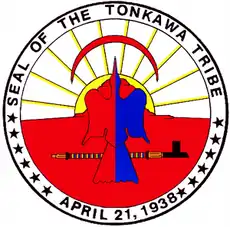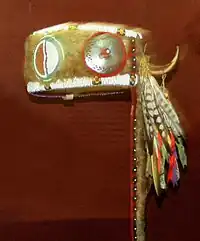 Seal of the Tonkawa Tribe of Oklahoma | |
| Total population | |
|---|---|
| 611[1] | |
| Regions with significant populations | |
| Languages | |
| English, formerly Tonkawa language | |
| Religion | |
| Christianity, Native American Church, traditional tribal religions | |
| Related ethnic groups | |
| Wichita, Waco, Tawakoni, Kichai, Guichita |
The Tonkawa are a Native American tribe indigenous to present-day Oklahoma.[2] Their Tonkawa language, now extinct,[3] is a linguistic isolate.[4]
Today, Tonkawa people are enrolled in the federally recognized Tonkawa Tribe of Indians of Oklahoma.
Name
The Tonkawa's autonym is Tickanwa•tic (meaning "real people"). The name Tonkawa is derived from the Waco tribal word, Tonkaweya, meaning "they all stay together".[2]
Economy
The Tonkawa tribe operates a number of businesses which have an annual economic impact of over $10,860,657 (as of 2011).[1] Along with several smoke shops, the tribe runs three different casinos: Tonkawa Indian Casino and Tonkawa Gasino located in Tonkawa, Oklahoma, and the Native Lights Casino in Newkirk, Oklahoma.[5]
Events

The annual Tonkawa Powwow is held on the last weekend in June to commemorate the end of the tribe's own Trail of Tears when the tribe was forcefully removed and relocated from its traditional lands to present-day Oklahoma.[6]
History
Scholars once thought the Tonkawa originated in Central Texas. Recent research, however, has shown that the tribe inhabited northwestern Oklahoma in 1601.[2] By 1700, Apache and Wichita enemies had pushed the Tonkawa south to the Red River which forms the border between current-day Oklahoma and Texas. In the 16th century, the Tonkawa tribe probably had around 1,900 members. Their numbers diminishes to around 1,600 by the late 17th century due to fatalities from new infectious diseases and conflict with other tribes, most notably the Apache.
In the 1740s, some Tonkawa were involved with the Yojuanes and others as settlers in the San Gabriel Missions of Texas along the San Gabriel River.[7]
In 1758, the Tonkawa along with allied Bidais, Caddos, Wichitas, Comanches, and Yojuanes went to attack the Lipan Apache in the vicinity of Mission Santa Cruz de San Sabá, which they destroyed.[8]

The tribe continued their southern migration into Texas and northern Mexico, where they allied with the Lipan Apache.[2][9]
In 1824, the Tonkawa entered into a treaty with Stephen F. Austin to protect Anglo-American immigrants against the Comanche. At the time, Austin was an agent recruiting immigrants to settle in the Mexican state of Coahuila y Texas. In 1840 at the Battle of Plum Creek and again in 1858 at the Battle of Little Robe Creek, the Tonkawa fought alongside the Texas Rangers against the Comanche.[10]
The Tonkawas often visited the capital city of Austin during the days of the Republic of Texas and during early statehood.[11]
In 1859, the United States escorted the Tonkawa and a number of other Texas Indian tribes to a new home at the Wichita Agency in Indian Territory, and placed them under the protection of nearby Fort Cobb. When the American Civil War started, the troops at the fort received orders to march to Fort Leavenworth, Kansas, leaving the Indians at the Wichita Agency unprotected.
In response to years of animosity (in part regarding rumors that the Tonkawas engaged in cannibalism [12][13] ), a number of pro-Union tribes, including the Delawares, Wichitas, and Penateka Comanches, attacked the Tonkawas as they tried to escape.[14] The fight, known as the Tonkawa Massacre killed nearly half of the remaining Tonkawas, leaving them with little more than 100 people. The tribe returned to Fort Griffin, Texas where they remained for the rest of the Civil War. In October, 1884, the United States removed them, once again, to the new Oakland Agency in northern Indian Territory, where they remain to this day. This journey involved going to Cisco, Texas, where they boarded a railroad train that took them to Stroud in Indian Territory, where they spent the winter at the Sac and Fox Agency. The Tonkawas travelled 100 miles (160 km) to the Ponca Agency, and arrived at nearby Fort Oakland on June 30, 1885.[lower-alpha 1]
On October 21, 1891, the tribe signed an agreement with the Cherokee Commission to accept individual allotments of land.[16]
By 1921, only 34 tribal members remained. Their numbers have since recovered to close to 700 in the early 21st century. The Tonkawa Tribe of Oklahoma incorporated under the Oklahoma Indian Welfare Act in 1938.[15]
Tonkawa groups
The Tonkawa were made up of various groups. These groups are generally counted as Tonkawa:
- Awash
- Choyopan
- Haiwal
- Hatchuknni
- Kwesh
- Mayeye
- Nilhailai
- Ninchopen
- Pakani
- Pakhalateh
- Sanukh
- Talpkweyu
- Titskanwaticha
See also
Notes
- ↑ From 1879 to 1885, some of the Nez Perce people who had surrendered at the end of the Nez Perce war had lived at Fort Oakland, near the present site of Tonkawa, Oklahoma[15]
References
- 1 2 2011 Oklahoma Indian Nations Pocket Pictorial Directory. Archived 2012-04-24 at the Wayback Machine Oklahoma Indian Affairs Commission. 2011: 36. Retrieved 8 Feb 2012.
- 1 2 3 4 May, Jon D. "Tonkawa (tribe)". The Encyclopedia of Oklahoma History and Culture. Oklahoma Historical Society. Retrieved 11 April 2021.
- ↑ International encyclopedia of linguistics. Frawley, William, 1953- (second ed.). New York, NY: Oxford University Press. 2003. ISBN 9780195307450. OCLC 66910002.
{{cite book}}: CS1 maint: others (link) - ↑ Hoijer, Harry (1933). Tonkawa, an Indian language of Texas. University of Pittsburgh Library System. New York : Columbia University Press.
- ↑ Oklahoma Indian Casinos: Kay County. 50 Nations. (retrieved 8 Feb 2009)
- ↑ Tonkawa Tribal History. Archived 2009-03-04 at the Wayback Machine The Tonkawa Tribe. (retrieved 7 Feb 2009)
- ↑ Gary Clayton Anderson, The Indian Southwest, 1580-1830: Ethnogenesis and Reinvention (Norman: University of Oklahoma Press, 1999) p. 85
- ↑ Anderson, The Indian Southwest, p. 89
- ↑ Walker, Jeff (2007-11-16). "Chief returns » Local News » San Marcos Record, San Marcos, TX". Sanmarcosrecord.com. Archived from the original on 2011-09-27. Retrieved 2011-11-11.
- ↑ Gwynne, S. C. (2011). Empire of the Summer Moon: Quanah Parker and the Rise and Fall of the Comanches, the Most Powerful Indian Tribe in American History. Scribner. pp. 7, 211. ISBN 978-1-4165-9106-1.
- ↑ Barnes, Michael "With time, the story of the Tonkawa tribe evolves" The Washington Post (February 13, 2014)
- ↑ Jones, William K. 1969. “Notes on the History and Material Culture of the Tonkawa Indians.” Smithsonian Contributions to Anthropology. Vol. 2, No. 5.
- ↑ Jerry Withers "The Tonkawan Indians of Texas" reprinted by SonsofDewittcolony.org
- ↑ : John D. May "Tonkawa Massacre" OKHistory.org
- 1 2 "Tonkawa Tribe of Indians of Oklahoma." Oklahoma State Department of Education. Oklahoma Indian Tribe Education Guide. July 2014. Accessed October 28, 2018.
- ↑ Deloria Jr., Vine J; DeMaille, Raymond J (1999). Documents of American Indian Diplomacy Treaties, Agreements, and Conventions, 1775-1979. University of Oklahoma Press. pp. 346–348. ISBN 978-0-8061-3118-4.
Further reading
- Himmel, Kelly F. (1999). The conquest of the Karankawas and the Tonkawas, 1821-1859. College Station, Texas: Texas A&M University Press. ISBN 978-0-89096-867-3.
External links
- Official website
- Jeffrey D. Carlisle: Tonkawa Indians from the Handbook of Texas Online